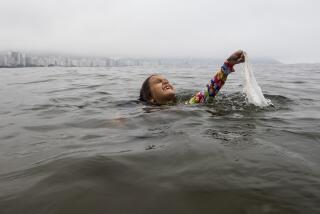Birth Mother Becomes Part of Extended Family
- Share via
ENCINO — Amanda Bialack, a precocious and outgoing 4-year-old, opened the front door of her family’s Encino home, the smile on her face hinting at her excitement.
“Hi!” she said, stretching up to exchange quick kisses with Jeanne Furie.
“Hi, bunky,” Furie said.
Hugs and kisses with Amanda’s parents, Maggie and Ed, followed before Furie, 24, joined them on the living room couch and began chatting. Amanda participated by joyfully climbing between them and, just as often, on them.
Later that evening, as she jumped up and down on her bed, Amanda was asked about Furie.
“She grew me,” Amanda explained.
Is she your mother? a visitor inquired.
“No. Maggie’s my mom,” Amanda replied, as if the answer were ridiculously obvious. “Jeanne’s my aunt.”
In truth, however, both Maggie and Jeanne are, in different ways, mother to Amanda. Maggie is her adoptive mother. Jeanne is her birth mother. Together, they represent a small but growing number of people involved over the last decade in the process known as cooperative adoption.
Cooperative adoption means that ongoing contact is maintained between the adoptive family and the biological mother (it is extremely rare for birth fathers to maintain contact).
The degree of contact varies and is controlled by the adoptive parents, who have legal say over the situation.
Contact may be restricted to a yearly exchange of letters and photos, or, as in Amanda’s case, may involve frequent face-to-face meetings with the birth mother and other blood relatives--Furie’s mother also sees Amanda regularly.
At age 2, when Amanda first began asking about the birth process, she was told that Maggie’s “stomach was broken” and that Furie helped out by “growing” Amanda for her parents, Ed and Maggie, who then adopted her. Just how much Amanda truly comprehends is unknown, given the mysteries of the 4-year-old mind.
Yet, at some level, Amanda understands and is comfortable with the situation, the Bialacks say. “I really think kids have a tremendous ability to put things in their place without complicating it with the psychobabble that adults add,” Maggie said.
Supporters hail cooperative adoption as a healthy alternative to traditional adoption, a process seen as cruelly secretive and detrimental to everyone, particularly the child. Maintaining contact, they say, helps adopted children deal with the deep psychological scars that can arise from feeling they were abandoned at birth and answers their questions about their identity.
“Children suffer great loss in adoption. The more we can cut that loss, the less they suffer,” said Sharon Kaplan, executive director of Parenting Resources in Tustin and a leading advocate of cooperative adoption.
However, its critics condemn cooperative adoption as a dangerous experiment that only complicates an already complex web of parent-child relationships.
“Adoption should be a total transfer of family membership, legally and socially,” said William Pierce, spokesman for the National Committee for Adoption, an independent agency in Washington advocating traditional adoption practices.
“Cooperative adoption strikes me as a kind of psychological joint custody or prolonged foster care,” he said. “Children need one set of parents they can rely on in an unambiguous way. Cooperative adoption is just a dangerous fad.”
The Bialacks and Furie acknowledge that their arrangement is a journey through uncharted waters that most people find troublesome. But they also feel strongly that their course of action is preferable to traditional adoption and has served them well. Amanda is thriving, they agree, and the openness of the arrangement has enriched all their lives.
“The only problem we’ve had so far is the response of other people who think we don’t know what we’re doing,” said Maggie, a 42-year-old bookkeeper. “But we do. We’re taking it step by step.”
If, in the future, cooperative adoption no longer appears to be in Amanda’s best interest, she said, the arrangement, which is entirely voluntary, will be reconsidered.
“She’s only 4. We have a long way to go with this,” Ed said. “We don’t have all the answers. We just know what our love and instincts tell us.”
The Bialacks were introduced to cooperative adoption by their social worker at Vista del Mar Child and Family Services, the Cheviot Hills agency that arranged Amanda’s adoption. Only about 2% of the 150 adoptions annually arranged at Vista del Mar involve cooperative adoption, according to officials there.
The Bialacks met Furie during the adoption and liked her (she was an unwed teen-ager; the birth father was already out of the picture). Still, they had their doubts.
“I was very threatened at first,” Maggie said. “My feeling was, just because I can’t bear children doesn’t mean I want to share parenting. The fear was that Amanda would automatically love her birth mother more and run off with her someday.”
Ed, an attorney who practices business law, said he also felt “very insecure, very threatened.”
Despite those feelings, the social worker, Selma Hersh, now retired and living in Carlsbad, recalled that the Bialacks “immediately sought to go beyond their fears. They responded positively to the idea because they felt it was best for Amanda.”
The first step, taken soon after Amanda’s adoption became final, was to contact Furie through the adoption service. A letter was sent suggesting further contact through the mail. But Furie, still agonizing over the loss of her child, rejected the idea.
The breakthrough came when Amanda was about 5 months old. A local television news program researching a story on cooperative adoption approached the Bialacks for an interview. They agreed and again contacted Furie to ask if she wanted to be included.
This time, Furie responded positively. “My situation had changed,” she said. “I had grieved enough. We hadn’t even talked yet about me seeing Amanda, but I decided that’s what I wanted to do. I wanted to know how she was doing.
“I didn’t realize at the time that it would lead to such a major change in my life.”


